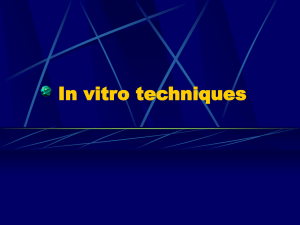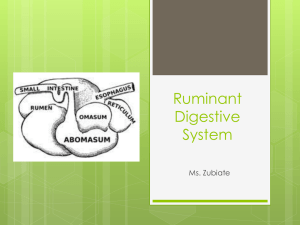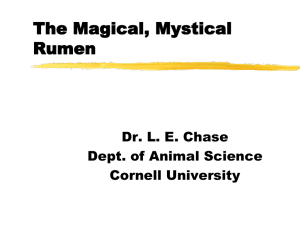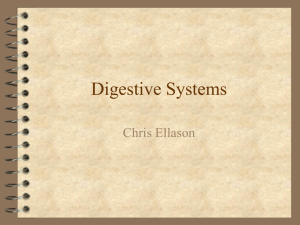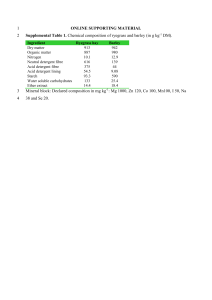rumen - Ed101 - Boston University
advertisement
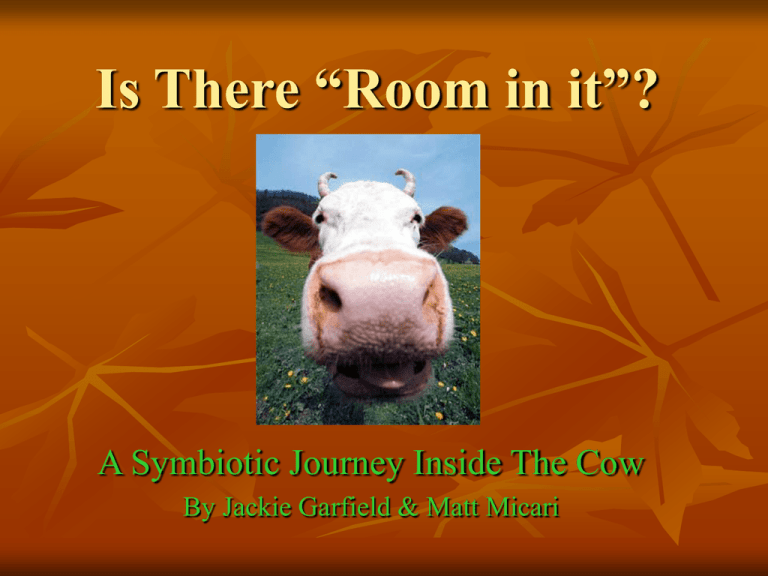
Is There “Room in it”? A Symbiotic Journey Inside The Cow By Jackie Garfield & Matt Micari In the next 20 minutes, we’ll… Define Ruminant Examine digestive system of cattle Discuss the symbionts Describe the new metabolism Explain how Infection occurs What is a Ruminant? Ruminant: (n.) any of the various cud-chewing mammals having a stomach divided into four compartments. Cows, sheep, moose, goats, antelope, and camels Follow the food… The Reticulum… Has thick walls and is puncture resistant Acts as a sieve Food is separated into layers of liquid and solid material The solids, known as cud, are regurgitated, rechewed, & reswallowed 500 times/day QuickTime™ and a TIFF (Uncompressed) decompressor are needed to see this picture. The Rumen A Fermentation Vat Volume: 180-240L Temp: 38- 42º C pH: 6.4 to 7.2 Rumen Microflora Unlike other symbioses, the focus is not the specificity but the variety of microbial symbionts Rumen Bacteria All three types of bacteria - Cocci, Rod, & Spirllia - are present Use cellulose, hemi-cellulose, starch, sugars, intermediate acids, proteins, and lipids. They regulate overall fermentation by reducing CO2 with H2 gas to form methane. Attachment of rumen bacteria on rice Protozoa Ingest bacteria for their protein source Control bacteria numbers in the rumen Genera of Protists Eu Eudiplodinium Ep Epidinium En Entodinium D Daystrichia O Ostracodinium El Enoplastron. Rumen Fungi Degrade cellulose and xylans Aid in fiber digestion Anaeromyces New Metabolism of the Ruminant Almost all glucose produced by breaking down cellulose is used by the symbiotic bacteria. Ruminants get their energy from the volatile fatty acids produced by bacteria: acetate, propionate & butyrate. Interconnected environments Contents in the rumen are not homogenous QuickTime™ and a TIFF (Uncompressed) decompressor are needed to see this picture. New and old material are pushed by muscular contractions & settle in the different layers Microbial Environments liquid phase solid phase microbial attachment Liquid Phase Free living microbes feed on soluble carbohydrates and protein 25% of microbial mass Solid Phase Microbes digest insoluble polysaccharides like starch and fiber 70% of microbial mass Microbial Attachment Microbes attach to rumen epithelial cells or protozoa Ensures consistant population numbers 5% of microbial mass Bacterial attachment to the bovine rumen epithelium http://www.ncl.ac.uk/camb/research/ The Omasum Only small particles of food pass into the omasum QuickTime™ and a TIFF (Uncompressed) decompressor are needed to see this picture. Also called the Butcher’s Bible Contains many folds to increase the surface area Water, electrolytes & more VFA’s are absorbed The Abomasum The true stomach Walls of the stomach secrete enzymes & HCl pH around 2.5 Proteins from microbes and remaining feed are broken down The Final Journey To the small and large intestines and beyond…… QuickTime™ and a TIFF (Uncompressed) decompressor are needed to see this picture. The next generation…. Does not have a developed rumen QuickTime™ and a TIFF (Uncompressed) decompressor are needed to see this picture. Becomes infected with microbes from drinking from udders of mother and grooming Rumen develops due to microbe activity as diet changes In Review Name 2 ruminants. Antelopes, goats, sheep, camels, & moose What are the four compartments of the ruminant stomach? Reticulum, Rumen, Omasum, & Abomasum What are VFA’s and why are they important to the ruminant? Volatile fatty acids / Energy source for cow The End QuickTime™ and a TIFF (Uncompressed) decompressor are needed to see this picture. Works Cited 29 Oct. 2005 <http://upload.wikimedia.org/wikipedia/commons/thumb/8/88/Billy_goat.jpg/250pxBilly_goat.jpg>. 29 Oct. 2005 <http://www.ca.uky.edu/agripedia/Classes/ASC106/media/RUMEN.GIF>. 29 Oct. 2005 <http://www.mekarn.org/procbuf/wanapat_files/image010.jpg>. 29 Oct. 2005 <http://www.r2gdesign.com/photogalleries/alaska/images/moose-in-the-midst2.jpg>. "Cow Rumen." Microbe Zoo: Animal Pavilion. Michigan State University. 05 Oct. 2005 <http://commtechlab.msu.edu/sites/dlc-me/zoo/zacmain.html>. Fincannon, Karen. Folk Sheep. Art Works. 29 Oct. 2005 <http://images.google.com/imgres?imgurl=http://www.karenfincannon.com/bigsheep.jpg&im grefurl=http://www.karenfincannon.com/sheeppaint.htm&h=351&w=500&sz=37&tbnid=Pw3 AfZYO4gwJ:&tbnh=89&tbnw=127&hl=en&start=8&prev=/images%3Fq%3Dsheep%26svnu m%3D10%26hl%3Den%26lr%3D>. "Focus on Milk: Rumen management is just as crucial at grazing." CMP Information Ltd Farmers Gardian 29 Apr. 2005: 82. Lexis Nexis. Boston University Mugar Library, Boston. 05 Oct. 2005. Keyword: rumen microflora. Frankenberg, C., J. F. Meirink, M. Van Weele, U. Platt, and T. Wagner. "Assessing Methane Emissions from Global Space-Borne Observations." Science 308 (2005): 1010-1014. 05 Oct. 2005. Hooper, Lora V., Melissa H. Wong, Anders Thelin, Lennart Hansson, Per G. Falk, and Jeffrey I. Gordon. "Molecular Analysis of Commensal Host-Microbial Relationships in the Intestine." Science 291 (2001): 881-884. 05 Oct. 2005. Ishler, Virginia, Jud Heinrichs, and Gabriella Varga, comps. "From Feed to Milk: Understanding Rumen Funtion." McGill University. 05 Oct. 2005 <http://animsci.agrenv.mcgill.ca/courses/450/extra/feed_to_milk/rumen.html>. Khalil, Mohammad. Omasum. 29 Oct. 2005 <http://education.vetmed.vt.edu/Curriculum/VM8054/Labs/Lab21/Examples/exom asum.htm>. Ed Mackie, Roderick I., and Bryan A. White. Gastrointestinal Microbiology. Chapman and Hall: New York. 1997. Ch 3, 10, & 11. McNaught, Megan. "First weeks are critical." Nationwide News Pty Limited Weekly Times (Australia) 27 July 2005, sec. Dairy: 105. Lexis Nexis. Boston University Mugar Library, Boston. 05 Oct. 2005. Keyword: rumen microflora. Pigden, W. J., and F. Bender. "Utilization of lignocellulose by ruminants." World Animal Review (1978). 05 Oct. 2005 <http://www.fao.org/DOCREP/004/X6512E/X6512E00.HTM>. Russell, James B., and Jennifer L. Rychlik. "Factors that Alter Rumen Microbial Ecology." Science 292 (2001): 1119-1122. 05 Oct. 2005. Stallings, Charles C. "Rumen Degradable Protein (RDP)." Virginia Cooperative Extension: Knowledge for the Commonwealth. Jan. 2002. Virginia Polytechnic Institute and State University. 05 Oct. 2005 <http://www.ext.vt.edu/news/periodicals/dairy/2002-01/rumen.html>. Yokoyama, Mel. Numbers of Different Rumen Microbes. Microbe Zoo. 05 Oct. 2005 <http://commtechlab.msu.edu/sites/dlc-me/zoo/zacmain.html>.

